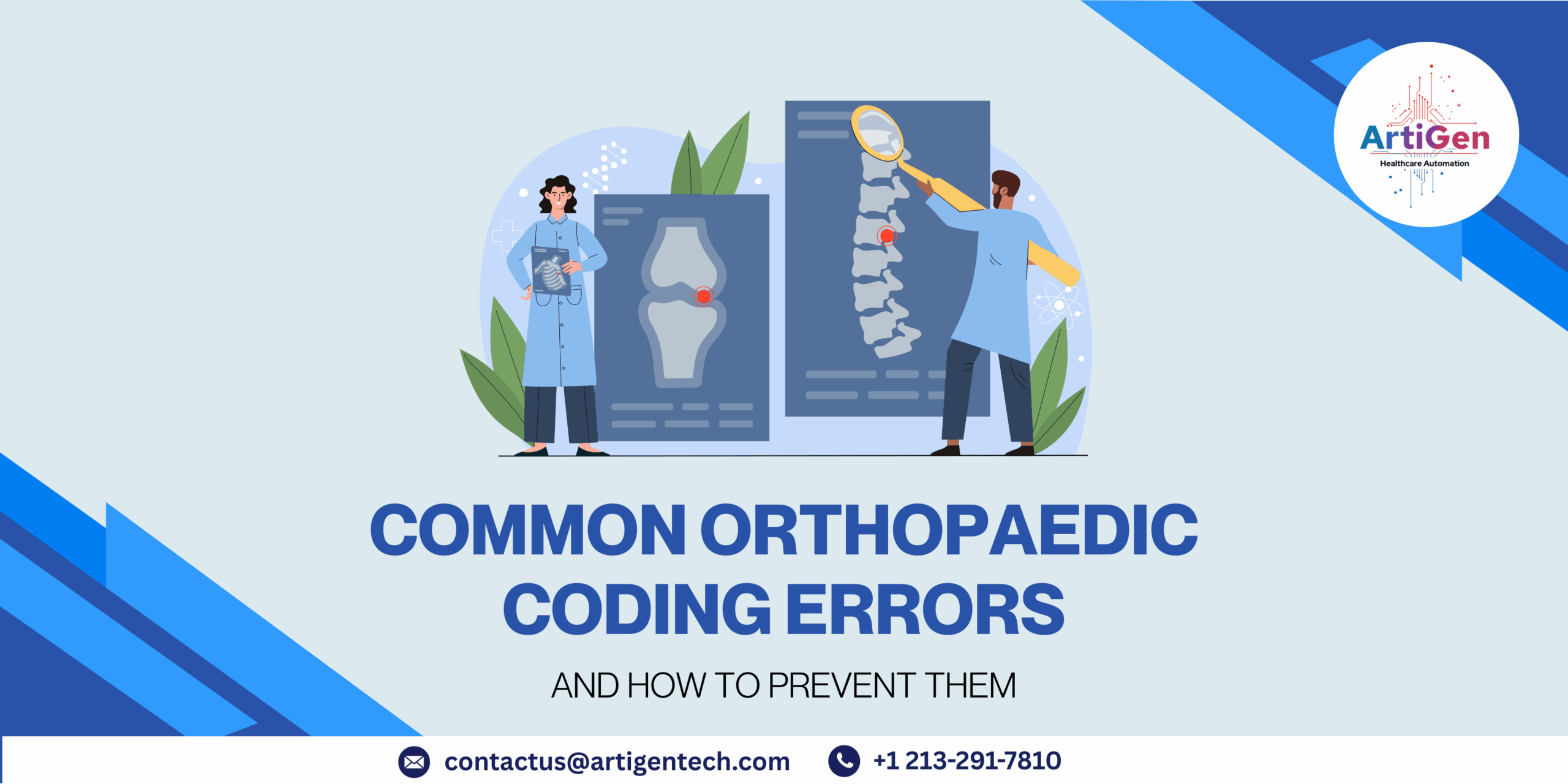

Orthopaedic Coding: Common Denials and their guidelines
In orthopaedic coding denials, injection-related errors are among the most frequent issues faced by providers. Leveraging medical coding automation can help minimize manual errors and enhance accuracy in orthopaedic coding workflows. Following accurate injection coding guidelines and orthopaedic coding guidelines helps prevent claim rejections and improves overall compliance in orthopaedic billing and coding.
Injections
- Missing laterality: Injections for conditions like osteoarthritis often require laterality (right/left) to be specified with modifiers -RT and -LT. Failing to use correct modifiers can trigger orthopaedic modifier denials and lead to rejections.
- Frequency limits: Denials can occur if injections coding guidelines (e.g., orthopaedic CPT codes 20610, 20605) are performed too frequently, as insurance payers have policies on the interval between repeated injections. Understanding payer-specific frequency rules is crucial for reducing common denials in orthopaedic coding.
- Inappropriate guidance billing: When a joint injection is performed with ultrasound guidance, the inclusive orthopaedic CPT code (e.g., 20611 for a major joint) must be used. Billing the major joint injection (20610) and the ultrasound guidance code (+77002 or +77021) separately can trigger a denial under NCCI bundling rules in orthopaedics.
Maintaining complete documentation and adherence to orthopaedic documentation requirements ensures cleaner claims and fewer orthopaedic coding denials related to joint injections coding guidelines.
Arthroscopy
General arthroscopy coding guidelines
- Diagnostic vs. surgical: A diagnostic arthroscopy is typically not billed separately if it is followed by a surgical procedure in the same joint during the same encounter. The diagnostic portion is considered a component of the surgical as per orthopaedic coding guidelines.
- Arthroscopic to open conversion: If an arthroscopic procedure is converted to an open one, you should report only the open procedure. Modifiers are not typically used to bill for both which helps reduce orthopaedic coding denials related to duplicate or overlapping claims.
- Laterality: Use modifiers -RT (Right side) and -LT (Left side) to indicate the specific side of the body on which the procedure was performed. This is crucial for avoiding orthopaedic CPT codes error and maintaining compliance with orthopaedic billing and coding rules.
Accurate documentation and correct modifier usage are vital components of orthopaedic coding guidelines, ensuring that all orthopaedic CPT codes are applied according to payer requirements and NCCI bundling rules in orthopaedics. Following these rules helps reduce the risk of orthopaedic coding denials and ensures claim acceptance in the first submission.
Knee arthroscopy
Arthroscopy of the knee is a common procedure with specific arthroscopy coding rules, particularly concerning debridement and meniscectomy.
Debridement and chondroplasty (articular cartilage shaving)
- CPT 29877: This code is for arthroscopic debridement or chondroplasty when it is the only procedure performed in the knee. Always verify that documentation aligns with the CPT and ICD-10 for orthopaedics to avoid denials.
- HCPCS G0289: For Medicare patients, use this code for arthroscopic debridement performed in a different compartment of the knee than another surgical procedure. This is a special Medicare code, and it should not be used for debridement in the same compartment as another surgery.
- Bundling rule: Do not bill for CPT 29877 or HCPCS G0289 alongside a meniscectomy (CPT 29880, 29881), because debridement is included in the definition of these meniscectomy codes as per orthopaedic billing compliance.
Accurate knee arthroscopy coding ensures the correct use of orthopaedic CPT codes, prevents duplicate submissions, and reduces the likelihood of orthopaedic coding denials. Staying aligned with orthopaedic coding guidelines and payer-specific edits strengthens claim approval rates for knee procedures.
Meniscectomy (meniscus removal)
- CPT 29880: Arthroscopy with meniscectomy of both the medial and lateral compartments. Accurate reporting of orthopaedic CPT codes and documentation in line with orthopaedic coding guidelines is crucial to avoid orthopaedic coding denials.
- CPT 29881: Arthroscopy with meniscectomy of either the medial or lateral compartment. Always ensure knee arthroscopy coding accurately reflects the procedure performed.
- Documentation requirement: Operative reports should clearly document whether the procedure was performed on the medial, lateral, or both compartments to ensure accurate orthopaedic CPT coding. This clarity supports compliance with orthopaedic billing and coding rules and reduces the risk of denials under NCCI bundling rules in orthopaedics.
Proper adherence to orthopaedic documentation requirements is essential during arthroscopy coding and ensures accurate linkage between CPT and ICD-10 for orthopaedics, supporting claim approval and minimizing payer rejections.
Synovectomy (removal of the inflamed joint lining)
- CPT 29875: For a limited synovectomy in the knee. Correct use of orthopaedic CPT codes and adherence to orthopaedic coding guidelines helps prevent orthopaedic coding denials.
- CPT 29876: For a major synovectomy in two or more compartments. When performing knee arthroscopy coding, ensure proper distinction between limited and major procedures to comply with orthopaedic billing and coding standards.
- Bundling rule: CPT 29875 is a “separate procedure” and cannot be billed with another knee arthroscopy procedure on the same knee. CPT 29876 may be billed with another arthroscopic knee procedure on the same side, provided the synovectomy is performed in compartments where no other arthroscopic procedure is taking place. This follows NCCI bundling rules in orthopaedics, which are essential for preventing claim rejections.
Following these orthopaedic documentation requirements and accurately mapping CPT and ICD-10 for orthopaedics ensures compliance, reduces errors, and strengthens clean claim submissions in orthopaedic billing and coding.
Shoulder arthroscopy coding
Shoulder arthroscopy coding is complex, with common codes for debridement, rotator cuff repair, and biceps tenodesis. Understanding arthroscopy coding and applying the correct orthopaedic coding guidelines is essential to avoid orthopaedic coding denials.
Debridement
- CPT 29822: For limited arthroscopic debridement of one or two structures, such as a limited labral debridement or minor trimming of degenerative cartilage. Clear orthopaedic documentation requirements are key here.
- CPT 29823: For extensive arthroscopic debridement of three or more structures. Proper documentation justifying the extensive nature of the debridement is essential. Clear orthopaedic documentation requirements are key here.
- Bundling rules:
- Limited debridement (29822) is often bundled into other, more extensive arthroscopic Shoulder arthroscopy coding procedures per NCCI bundling rules in orthopaedics.
- Extensive debridement (29823) may be reported separately alongside other procedures like a rotator cuff repair (29827) or biceps tenodesis (29828) if the debridement is performed in a different area of the shoulder. Following orthopaedic CPT codes correctly minimizes common denials in orthopaedic coding.
Accurate coding under CPT and ICD-10 for orthopaedics and attention to orthopaedic modifier denials ensure smooth reimbursement and reduce compliance risks in orthopaedic billing and coding workflows.
Documentation requirements
Thorough and clear documentation is the most powerful tool for preventing orthopaedic claim denials. For all arthroscopic procedures and orthopaedic billing claims, the operative report must clearly state:
- The joint and specific side (e.g., right knee).
- The exact procedures performed.
- The compartments or structures addressed.
- The extent of any debridement (for extensive debridement, specify the number of structures and areas).
- Separate compartment” documentation: For knee arthroscopies (e.g., CPT 29881), billing for procedures like chondroplasty (G0289) requires specific documentation that the procedures were performed in a separate compartment of the joint. Proper documentation ensures accuracy in orthopaedic coding and helps reduce claim denials related to incomplete operative details.
- Improper use of modifier -59: Payers scrutinize modifier -59 when used for shoulder arthroscopies in orthopaedic billing. For example, billing for extensive debridement (29823) with a rotator cuff repair (29827) on the same shoulder with modifier -59 is often denied, despite different interpretations by coding bodies. Accurate modifier use is essential to prevent orthopaedic claim denial.
- Bundling of debridement: Many arthroscopic procedures have limited debridement (CPT 29822) bundled into the main procedure code. Billing for both can lead to a denial based on National Correct Coding Initiative (NCCI) edits. Understanding bundling rules and following orthopaedic coding compliance guidelines is crucial to avoid unnecessary claim denials in orthopaedic billing
Fracture care coding
Accurate orthopaedic billing for fracture care depends heavily on clear ICD-10 and CPT code alignment. Many orthopaedic claim denials occur due to mismatched diagnosis and procedure codes or incomplete documentation.
- Unlinked diagnosis and procedure: The ICD-10 diagnosis code must specify the type, location, and laterality of the fracture care coding. A generic ICD-10 code for a fracture care coding is likely to be denied if the CPT code is for a specific, complex repair. Always ensure that fracture coding documentation supports the procedure’s complexity and anatomical detail to prevent denials in orthopaedic billing.
- Inadequate documentation: The operative note must clearly describe the treatment method (e.g., closed treatment, open reduction, internal fixation) to support the billed CPT code. Inconsistent or vague orthopaedic documentation often leads to claim denials and audit risks.
- Bundling of supplies: For casting and strapping, providers may get denied if they bill for both the E/M visit and the application of a pre-fabricated splint. The application is often included in the visit, and a separate HCPCS L-series code should be used for the supply. Following proper orthopaedic billing rules for fracture care treatment ensures compliant reimbursement and reduces the likelihood of orthopaedic claim denials.
Common modifiers that trigger denials
- Modifier 25 (Significant, Separately Identifiable E/M Service): Often used incorrectly on the same date as a minor procedure. The E/M service must be significantly beyond the usual pre-procedure work and thoroughly documented to avoid modifier-related denials in orthopaedic billing.
- Modifier 50 (Bilateral Procedure): Denials can occur if this modifier is used with a CPT code description that already specifies a bilateral procedure. Always verify the CPT modifier guidelines and payer-specific policies before applying Modifier 50.
- Modifier 59 (Distinct Procedural Service): Frequently misused to bypass NCCI edits. Improper use of modifier -59 is a major cause of audits and orthopaedic coding denied if the services are not truly distinct.
- Modifier 78 (Return to Operating Room): This is used for an unplanned return to the OR for a complication of the initial surgery within the global period. Using it incorrectly for a planned or unrelated procedure will result in a claim denial and possible orthopedic billing compliance.






